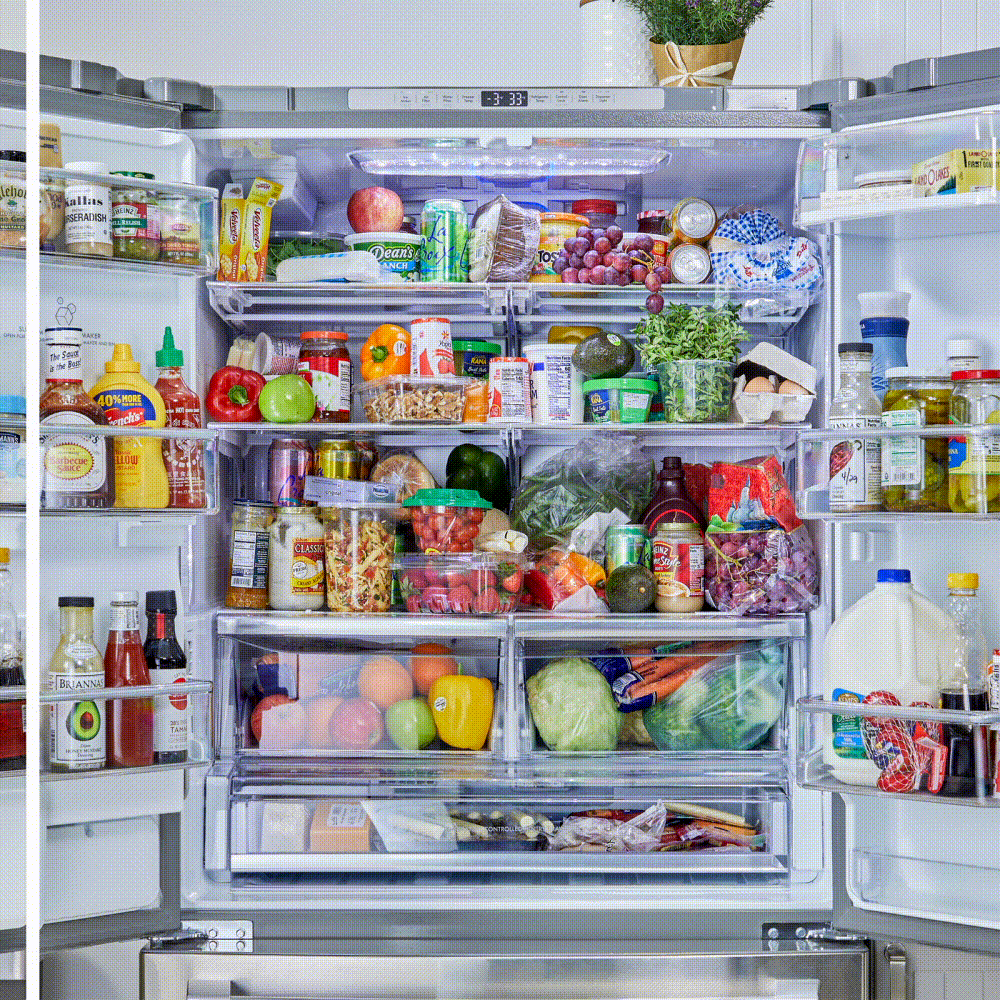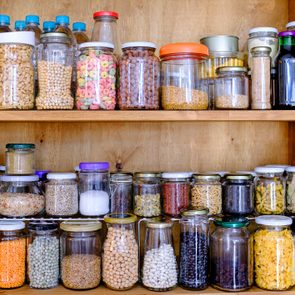12 Smart, Simple Tricks for Organizing a Kitchen Sink So You Can Find Everything You Need in Seconds
Updated: Apr. 12, 2024
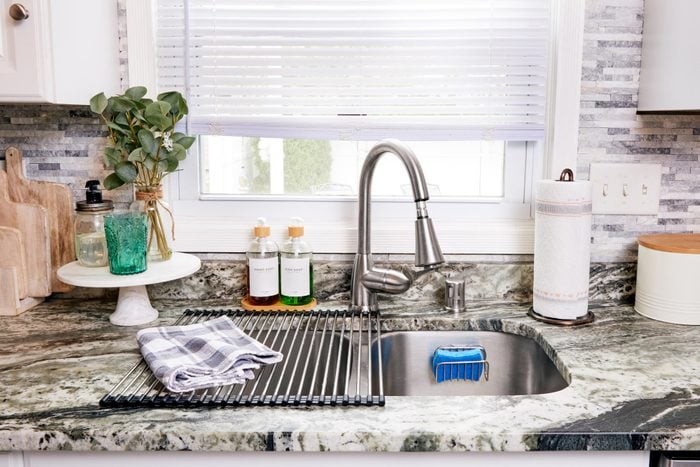
Say goodbye to unsanitary, sopping sponges and difficult-to-reach disinfectant. Organizing the kitchen sink area helps keep things clean, clutter-free and convenient.
When it comes to kitchen organization, you could argue that the overworked and often-overlooked area around the sink deserves the most attention. Streamlining this multipurpose space makes things more accessible and easy to keep clean. And since the sink beats even the toilet seat as the germiest place in our homes, organizing the kitchen sink is important.
And it’s not just about focusing on kitchen counter organization, like ousting the clutter of slimy soaps, soggy sponges and pulpy paper towels. You’ll also want to reconfigure under-sink storage to get rid of the jumbled junk drawer–like mess of cleaning products, tools, grocery bags and random supplies. Not sure where to start when organizing your kitchen sink? These ideas will help you knock the space into shape.
Get Reader’s Digest’s Read Up newsletter for organization, humor, cleaning, travel, tech and fun facts all week long.
1. Declutter and prioritize items
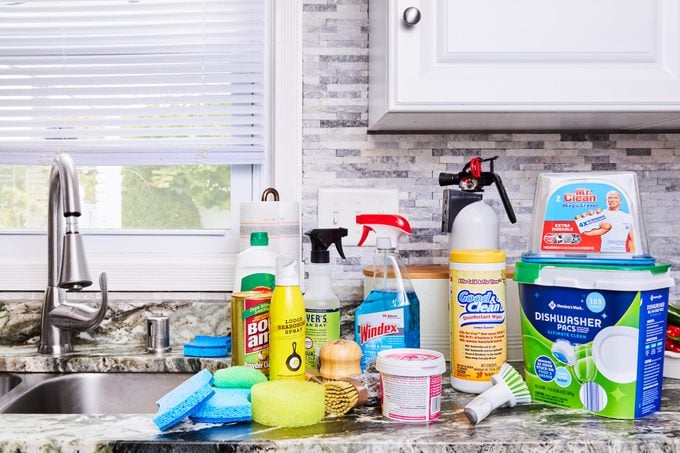
When organizing your kitchen sink area, the first thing you’ll want to do is gather all the items from the counters, drawers and under-sink cupboard and place them in front of you for review. Do you really need such a big pile of old rags? Has that wonky drain-cleaning brush seen better days? And is the under-sink cupboard the best place to keep your hammer and screwdrivers? Create piles to toss, save and rehome. Do some things belong in an appliance garage or other convenient stowaway spaces? Only keep what you need and will use in that immediate area—there are better places to store your toilet cleaning supplies.
2. Divide into zones
Once you have your keep pile, categorize the items into groups based on where you want to store them—and how you use them. It’s probably better to have your soap and sponge on the counter for easy access. Tuck away spare items, bulky boxes and strong chemical cleaners in the child-proof under-sink cupboard. Reserve the items you use the least for the furthest-away spot on those cupboard shelves—stretching to the back whenever you need the dishwashing liquid isn’t sensible.
3. Introduce a sponge holder
Are you guilty of leaving your soggy, food-filled sponge lying in the kitchen sink? Sponges are breeding grounds for bacteria. Using a sponge holder keeps things accessible, shipshape and sanitary. Whether you go for a style with suction cups or one that straddles your sink divider, ensure it has drainage holes. After you clean your sponge, you want it to dry properly.
4. Use a soap dish
If you leave your soap sitting on the countertop, it might slide off and go missing, and it can leave a slimy residue. Invest in a dedicated dish to keep your soap in one place and your counters goop-free.
5. Add an over-the-sink drying rack
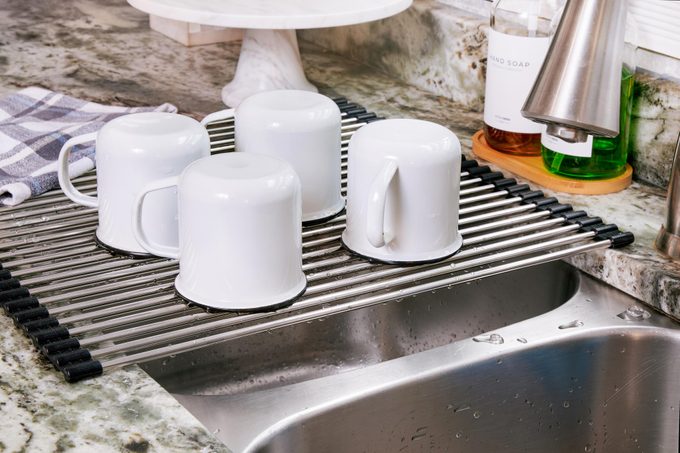
While using a dishwasher is the most hygienic way to wash dishes, you still need to scrub some items in the sink. Why not integrate an over-the-sink drying rack that drains directly into your basin? No more soaked towels next to the sink. And once you’re done drying, roll the drying rack up, store it under the counter, close the cupboard and that once wet drying rack remains out of sight.
6. Fit a tension rod
For a budget kitchen sink organization hack, use a tension rod. You might already have one of these easy-to-install accessories holding up curtains or mini blinds. Fit one to the underside of your kitchen cabinet above the sink or across the interior of the cabinet below the sink. Depending on where it’s located, you can use it to hold paper towels or suspend cleaning spray bottles. And because they don’t need any screws, glue or other fasteners to hold them in place, they’re perfect for DIY novices or renters.
7. Use the back of your cupboard doors
When you’re short on storage space and don’t want a lot of external clutter, maximize your vertical space by using the inside of your under-sink cupboard door. Hang handy hooks for your dish towels, rubber gloves and scrubbing brushes. A hanging storage organizer provides discreet designated spaces for the little, lightweight items that get easily lost in a cavernous cupboard—think shopping bags, cleaning tools and dishwasher tablets. Buy extra hooks and use this small kitchen storage idea in other cabinets.
8. Store items in stackable containers
Learning how to organize kitchen cabinets is always challenging, but organizing the kitchen sink cabinets is even more difficult thanks to the under-sink pipework. A great space-saving kitchen storage idea is to use containers rather than shelving. It means you can stack them around the piping, keep similar items together and easily find and grab the things you need. Because the containers are hidden in the cupboard, go for function over form. Clear, budget plastic bins or baskets will do the job just fine.
Containers are also handy if you want to decant smaller quantities from those chunky refill boxes of dishwasher tablets and big bottles of dish soap. And don’t forget labels—there are lots of things you shouldn’t clean with dish soap, and you don’t want to muddle it up with your fabric softener.
9. Integrate clever under-sink shelving
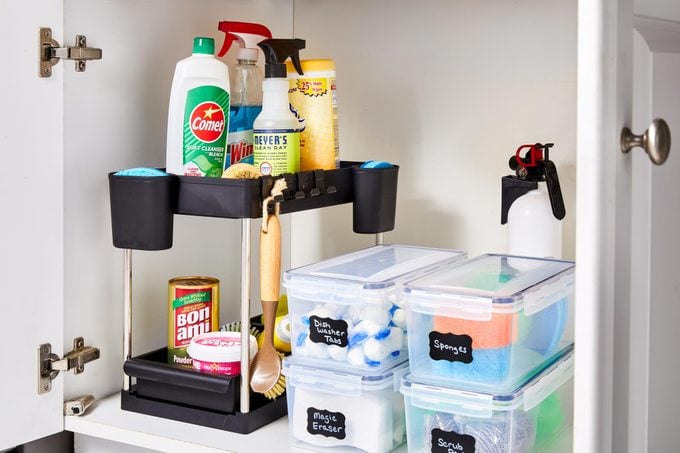
Another strategy for making the best use of the space around under-sink pipework is to use smart shelving systems or under kitchen sink organizers. Under-sink organizers with retractable shelving make accessing the back of those deep cupboards easier, and using two tall, thin units means they can sit on either side of the drain.
10. Add a roll holder
Hang a roll holder above your sink to prevent your paper towels from going soggy on the counter. It also makes it easy to grab a few sheets. Roll holders can also work on the back of the under-sink cupboard door for storing things like aluminum foil, clingy plastic wrap or rolls of sandwich bags.
11. Tuck away your trash
The under-sink cupboard is an ideal place to hide your trash or composting bin. If the cupboard has a child-proof lock, why not put that not-so-attractive and slightly smelly organic waste bin in this spot? Leaving food bins in reach of pets is a recipe for disaster. If your dog manages to dig in, they risk exposure to highly toxic mold growing on decomposing food.
12. Install task lighting
Sinks sitting under kitchen cabinets are often dimly lit. This isn’t ideal when you’re trying to clean up clutter or distinguish between different cleaning bottles. Adding an over-the-sink pendant light or rechargeable under-the-cabinet task lighting means you can better tell if you’ve gotten rid of all the grime when cleaning your kitchen sink.
Sources:
- Journal of Applied Microbiology: “Reduction of Faecal Coliform, Coliform and Heterotrophic Plate Count Bacteria in the Household Kitchen and Bathroom by Disinfection with Hypochlorite Cleaners”
- Scientific Reports: “Microbiome analysis and confocal microscopy of used kitchen sponges reveal massive colonization”
- Companion Animal: “Tremorgenic mycotoxicosis in dogs”

